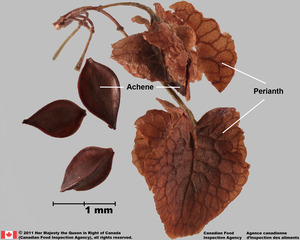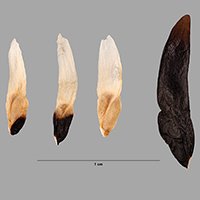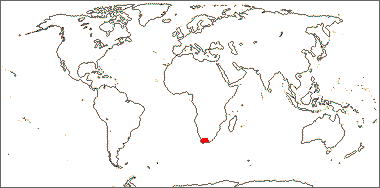Family name: Lanariaceae H. Huber ex R. Dahlgren
Synonym(s): [none]
Common name(s): lanaria family
*Number of genera/species: 1/1
List of genera records in GRIN-Global
seed
Fruit a loculicidal capsulecapsule:
a dry, dehiscent fruit derived from a compound ovary , 3–8 mm long, globoseglobose:
, 3–8 mm long, globoseglobose:
3D shape—more or less spherical , tereteterete:
, tereteterete:
approximately circular in cross section; width and thickness approximately equal
 in transection, with one seed, covered by persistent white, wooly perianthperianth:
in transection, with one seed, covered by persistent white, wooly perianthperianth:
collective term for calyx and corolla of a flower
 . Pericarppericarp:
. Pericarppericarp:
fruit wall or fruit coat
appears white, pubescentpubescent:
surface relief—bearing hairs
.
Seeds globoseglobose:
3D shape—more or less spherical , 1–2 mm long. Seed coat black, shinyshiny:
, 1–2 mm long. Seed coat black, shinyshiny:
uniformly reflecting a high proportion of incident light at all angles , phytomelanphytomelan:
, phytomelanphytomelan:
carbonaceous, opaque material that usually covers the seed coat to give it a black appearance, common in certain monocot families encrusted.
encrusted.
Embryo curvedcurved:
(of embryo) linear embryo is curved into an arch or horseshoe with the ends far apart , about as long as endosperm.
, about as long as endosperm.
Endosperm copious.
| Fruit | |
| Type | capsulecapsule: a dry, dehiscent fruit derived from a compound ovary  |
| Size range | 3–8 mm long |
| Shape(s) | globoseglobose: 3D shape—more or less spherical  |
| Surface relief | pubescentpubescent: surface relief—bearing hairs (perianthperianth: collective term for calyx and corolla of a flower  ) ) |
| Color(s) | white |
| Unique features | One-seeded, globoseglobose: 3D shape—more or less spherical  capsulescapsule: capsulescapsule:a dry, dehiscent fruit derived from a compound ovary  covered by white, wooly persistent perianthperianth: covered by white, wooly persistent perianthperianth:collective term for calyx and corolla of a flower  . . |
| Seed | |
| Size range | 1–2 mm long |
| Shape(s) | globoseglobose: 3D shape—more or less spherical  |
| Surface relief | crustaceouscrustaceous: texture—thin, dry, indurate, and brittle |
| Color(s) | black |
| Unique features | Globoseglobose: 3D shape—more or less spherical  seeds, black, phytomelan-encrusted, and shinyshiny: seeds, black, phytomelan-encrusted, and shinyshiny:uniformly reflecting a high proportion of incident light at all angles  . . |
| Other | |
| Embryo | curvedcurved: (of embryo) linear embryo is curved into an arch or horseshoe with the ends far apart  , about as long as endosperm , about as long as endosperm |
| Nutritive tissue | endosperm copious |
Cape Province, South Africa.

Distribution map courtesy of Angiosperm Phylogeny Website.
Baskin and Baskin 2021Baskin and Baskin 2021:
Baskin C and Baskin J. 2021. Relationship of the lateral embryo (in grasses) to other monocot embryos: A status up-grade. Seed Science Research 31 (3): 199-210. doi:10.1017/S0960258521000209; Dahlgren et al. 1985Dahlgren et al. 1985:
Dahlgren RMT, Clifford HT, and Yeo PF. 1985. The families of the monocotyledons: structure, evolution, and taxonomy. Springer-Verlag, Berlin. 520 pp.; Kirkbride et al. 2006Kirkbride et al. 2006:
Kirkbride JH, Jr, Gunn CR, and Dallwitz MJ. 2006. Family guide for fruits and seeds, vers. 1.0. Accessed September 2020-January 2022. URL: https://nt.ars-grin.gov/seedsfruits/keys/frsdfam/index.cfm .; Kubitzki et al. 1990+Kubitzki et al. 1990+:
Kubitzki K et al., eds. 1990+. The families and genera of vascular plants. 7+ vols. Berlin etc.; Stevenson and Loconte 1995Stevenson and Loconte 1995:
Stevenson DW and Loconte H. 1995. A cladistic analysis of monocot families. In: Rudall PJ, Cribb PJ, Cutler DF, and Humphries CJ, eds. Monocotyledons: Systematics and Evolution. Royal Botanic Gardens, Kew.; Takhtajan 2009Takhtajan 2009:
Takhtajan A. 2009. Flowering plants: Second edition. Springer Nature, Switzerland. 871 pp.; Thiselton-Dyer 1896–1897Thiselton-Dyer 1896–1897:
Thiselton-Dyer WT. 1896–1897. Flora capensis: being a systematic description of the plants of the Cape colony, Caffraria, & Port Natal (and neighbouring territories). Vol. 6. L. Reeve, Kent UK. 563 pp. https://doi.org/10.5962/bhl.title.821
*The number of genera and species is based on Christenhusz and Byng 2016Christenhusz and Byng 2016:
Christenhusz MJM and Byng JW. 2016. The number of known plant species in the world and its annual increase. Phytotaxa 261 (3): 201-217. https://doi.org/10.11646/phytotaxa.261.3.1, which may differ from the number of genera in GRIN-Global.
|
For fruit and seed images see Flora of the World.
|